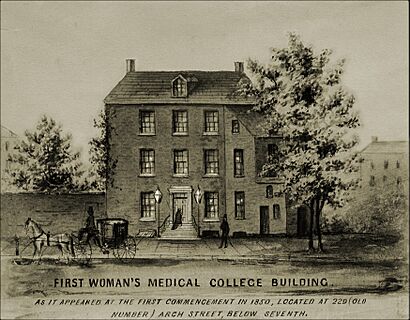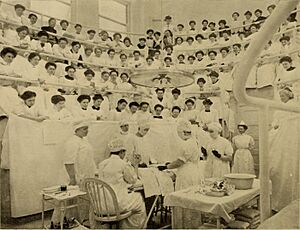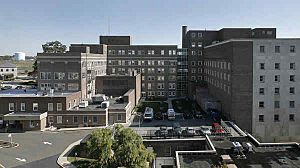Woman's Medical College of Pennsylvania facts for kids

An 1850 illustration of the first building at Woman's Medical College of Pennsylvania in Philadelphia
|
|
|
Other name
|
WMCP |
|---|---|
|
Former name
|
Female Medical College of Pennsylvania, Medical College of Pennsylvania |
| Active | 1850–1970 (became co-ed Medical College of Pennsylvania) |
| Address |
229 Arch Street (until 1858) and then 627 Arch Street (after Philadelphia's street renumbering)
,
,
,
U.S.
|
The Woman's Medical College of Pennsylvania (WMCP) was a very important school. It opened in 1850 and was first called The Female Medical College of Pennsylvania. This college was the first in America to teach women how to become doctors and earn a Doctor of Medicine degree.
In 1867, its name changed to the Woman's Medical College. Over the years, it trained thousands of women doctors from all over the world. Many of these doctors went on to practice medicine in different countries.
Contents
A Special Place for Women in Medicine
The Woman's Medical College of Pennsylvania has a truly special history. It was one of the first colleges created specifically to teach women medicine.
Why It Was Started
The college was founded by a group of people called Quakers. They believed strongly that women should have the same chances as men to get an education. They also felt that women should be able to become doctors.
Opening Doors for Everyone
This college offered medical training to women from many different backgrounds. Some of these women were the first from their country or race to earn a medical degree. For example, it gave opportunities to the first Native American women and African-American women to study Western medicine. Women from India, Syria, Japan, and Canada also came to study here.
Learning and Leading
At the time, it was rare for women to teach, do research, or help run a medical school. The Woman's Medical College of Pennsylvania made this possible. In 1861, the Women's Hospital was opened. This allowed women to learn and practice medicine in a hospital setting.
A New Campus
In 1930, the college moved to a new campus in the East Falls area of Philadelphia. This new building was special because it combined teaching and hospital care in one place. It was the first hospital in the country built specifically for this purpose.
Becoming Co-Ed
The Woman's Medical College was the longest-running medical college for women in America. In 1970, it started admitting men, becoming a co-educational school. Its name then changed to The Medical College of Pennsylvania.
Joining Other Schools
Later, in 1993, the college and hospital joined with Hahnemann Medical School. Then, in 2003, both colleges became part of Drexel University College of Medicine.
The People Who Started It
Many important people helped create the Woman's Medical College.
Early Leaders
- William J. Mullen (1805–1882) was the first president of the college's board. He was a wealthy businessman who cared about helping others.
- Joseph S. Longshore (1809–1879) was a Quaker doctor who worked to end slavery.
- Dr. Bartholomew Fussell (1794–1871) was also an abolitionist. He was the uncle of Dr. Edwin Fussell, who was one of the first teachers at the college.
The Idea for the College
It is said that Dr. Bartholomew Fussell first suggested the idea for a college to train female doctors in 1846. He wanted to honor his sister, who he believed could have been a doctor if women had been given the chance back then.
At a meeting at Fussell's house, in Kennett Square, Pennsylvania, he invited five doctors to help make his idea happen. These doctors were: Edwin Fussell, Franklin Taylor, Ellwood Harvey, Sylvester Birdsall, and Dr. Ezra Michener.
Dr. Fussell supported the college, but he was not very involved after it opened in Philadelphia in 1850. Ellwood Harvey, who was at that 1846 meeting, started teaching at the college in 1852.
Support for Women's Rights
The Feminist Movement in the 1800s helped gather support for the Female Medical College of Pennsylvania. The Society of Friends (a large group of Quakers) in Philadelphia strongly supported women's rights and the creation of this college.
The college was first located at 229 Arch Street in Philadelphia. In 1858, when Philadelphia renumbered its streets, the address changed to 627 Arch Street. In July 1861, the college rented rooms from the Woman's Hospital of Philadelphia.
Who Ran the College
The college had several leaders, called deans, over the years.
Early Deans
The first dean of the Female Medical College was Nathaniel R. Mosely, who served from 1850 to 1856. The second dean was also a man, Edwin B. Fussell, from 1856 to 1866.
Women Leaders
After that, the college had a long history of women deans. Ann Preston was the first woman to become a dean of a medical school in the United States. Dr. Preston worked hard to make sure her students received the best training. She arranged for them to attend medical demonstrations at the Blockley Almshouse in West Philadelphia.
Here are some of the women who served as deans:
- 1866–1872: Ann Preston
- 1872–1874: Emeline Horton Cleveland
- 1874–1886: Rachel Bodley
- 1886/1888–1917: Clara Marshall
- 1917–1940: Martha Tracy
- 1940/1943–1943/1946: Margaret Craighill
- 1946–1963: Marion Spencer Fay
After Marion Fay, a man named Glen R. Leymaster became dean from 1964 to 1970. In 1970, the school became known as the Medical College of Pennsylvania.
Challenges in Training Doctors
The Female Medical College of Pennsylvania faced challenges in providing hands-on training for its students. This was because women often struggled to be accepted in the medical world, which was mostly run by men.
Dr. Ann Preston fought for her female students to get more clinical training. When the women attended lectures in the surgical amphitheater, they sometimes faced rude behavior from male medical students.
As surgery and other medical specialties grew, almost all medical schools needed more practical training. In the 1880s, the Woman's Medical College of Pennsylvania mainly used demonstration clinics for teaching.
In 1887, Anna Broomall, a professor of obstetrics (the study of childbirth), started a maternity outpatient service in a poor area of South Philadelphia. This allowed students to gain real-world experience. By 1895, many students helped three or four women give birth.
The East Falls Campus and Drexel University
The East Falls Campus was the first hospital in the country built specifically for both teaching and patient care. This design helped provide more hands-on medical experience. After World War II, there was a shortage of housing in the city. This led to new buildings being added to the East Falls Campus. One of these was the Ann Preston Building, which provided housing and classrooms for student nurses.
Today, this building is known as the Falls Center. It is used for student housing, businesses, and medical offices.
In 1993, the Medical College of Pennsylvania joined with Hahnemann Medical College. In 2003, both medical colleges became part of Drexel University College of Medicine. This created new chances for many students to get practical experience in different medical settings, from big city hospitals to small country practices.
Famous Graduates
Many amazing women who studied at the Woman's Medical College of Pennsylvania went on to do great things.
- Honoria Acosta-Sison: Graduated in 1909. She was the first Filipino woman to become a medical doctor. She later became a professor and head of the obstetrics and gynecology department at the University of the Philippines.
- Ella Garber (Bauman): Graduated in 1924. She founded the Champa General Hospital in Champa, India, and worked there as a missionary doctor from 1926 to 1961.
- Rebecca Cole: The first Black woman to graduate from the Woman's Medical College with an MD in 1867. Other notable Black graduates included Caroline Still Anderson, Eliza Ann Grier, Matilda Evans, and Georgianna E. Patterson Young.
- Sabat Islambouli: Graduated in 1890. She was the first female doctor from Syria.
- Mary Putnam Jacobi: A leading American woman medical scientist in the 1800s.
- Anandibai Joshi: Graduated in 1886. She was the first Indian woman doctor.
- Kei Okami: Graduated in 1889. She was the first Japanese woman to earn a degree in Western medicine.
- Jane Paine: Graduated in 1861, first in her class. Her thesis was about "A disquisition on women as physicians." A historical marker was placed in Mount Vernon, Ohio, where she practiced medicine.
- Susan La Flesche Picotte: The first Native American woman to earn a medical degree.
- Ann Preston: A member of the first graduating class and later became the first female dean of a medical school in the United States.
- Laura Matilda Towne: Founded the Penn School in 1862.
- Charlotte Yhlen: Graduated in 1873. She became the first Swedish woman to graduate from a medical school.
The college also welcomed many Jewish students in the 1800s.
See also
 In Spanish: Woman's Medical College of Pennsylvania para niños
In Spanish: Woman's Medical College of Pennsylvania para niños
- List of defunct medical schools in the United States
- List of female scientists before the 20th century
- Women in medicine
Further research
- Archives at Drexel University College of Medicine
- Woman's Medical College of Pennsylvania materials in the South Asian American Digital Archive (SAADA)



